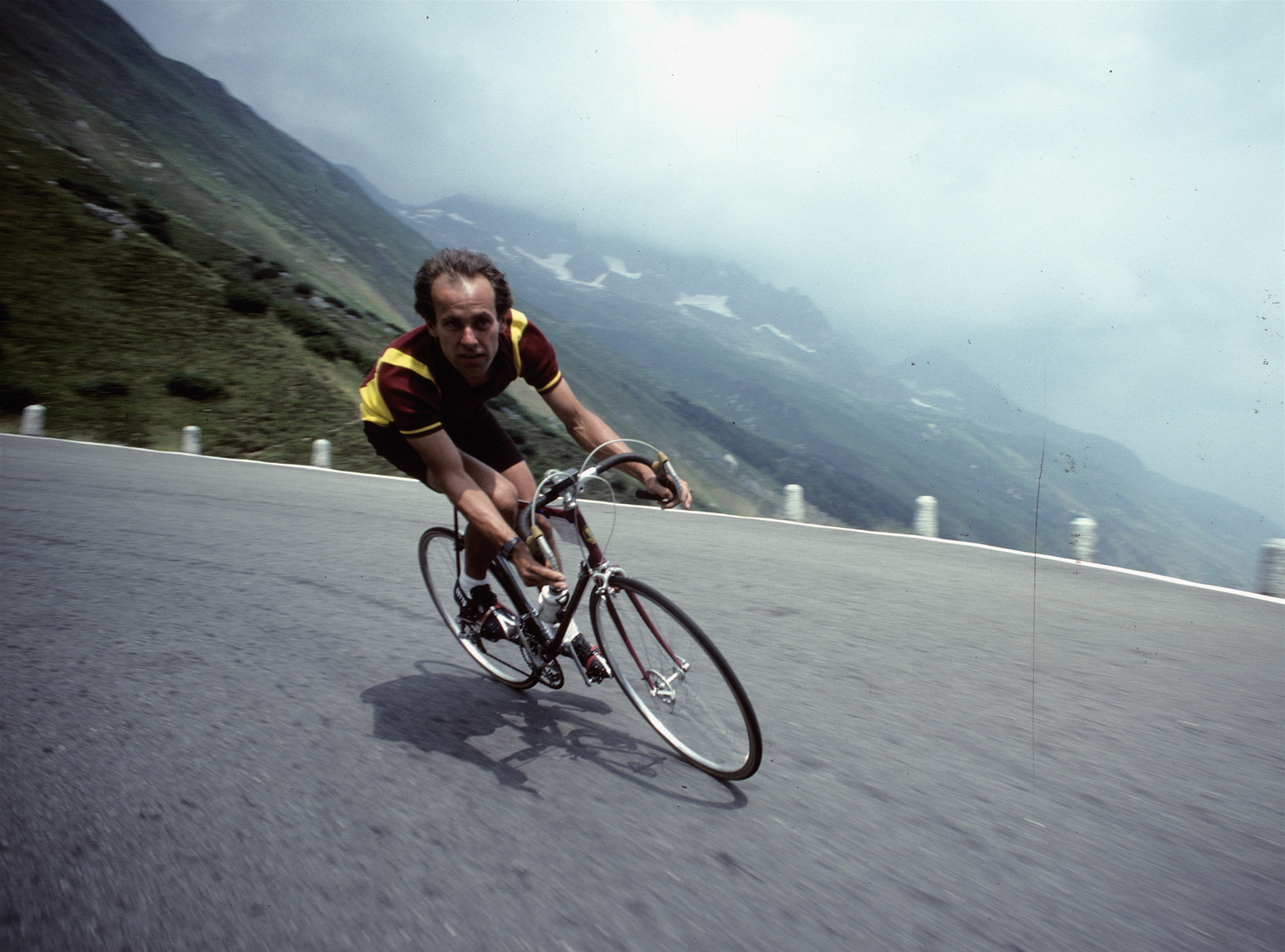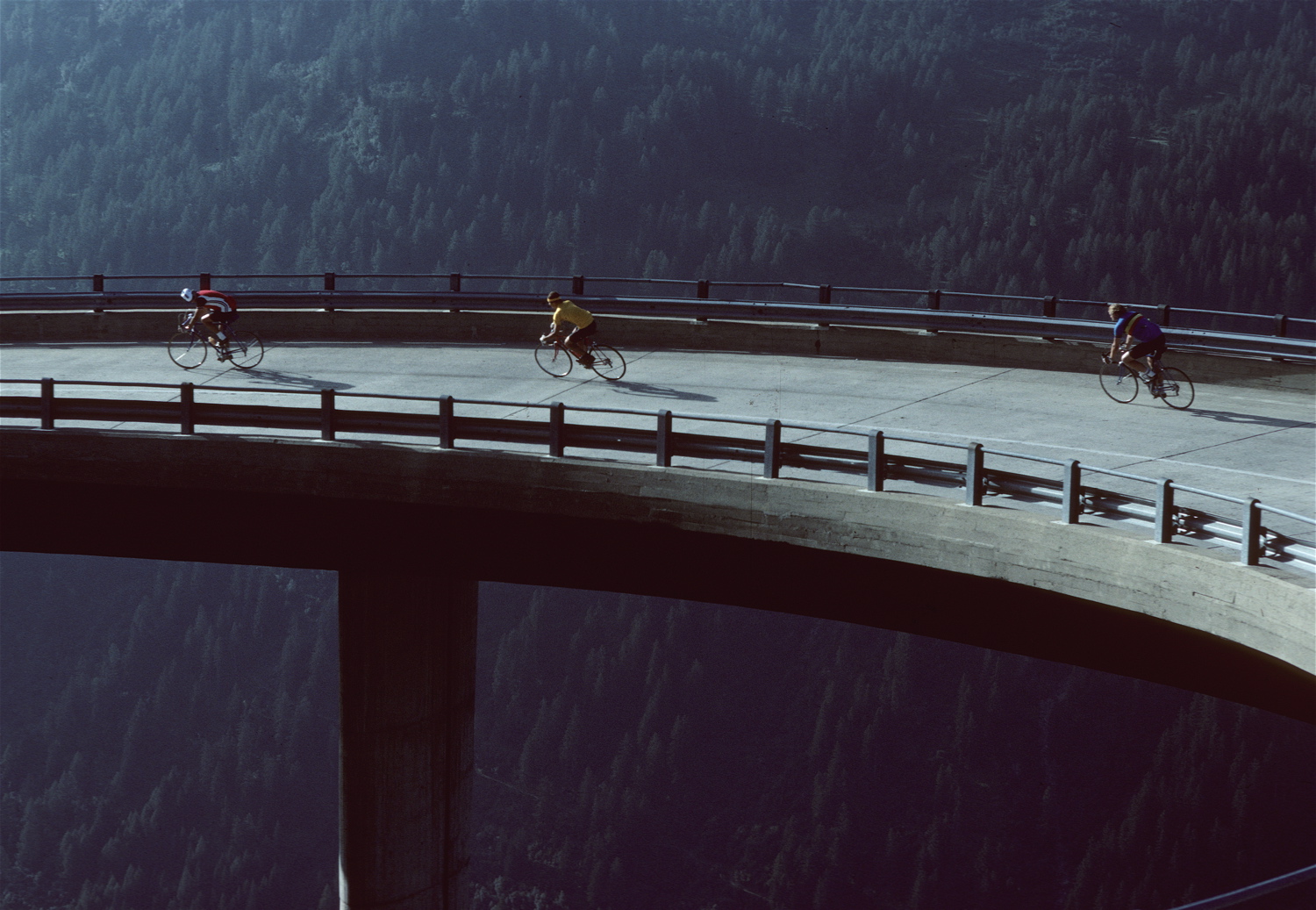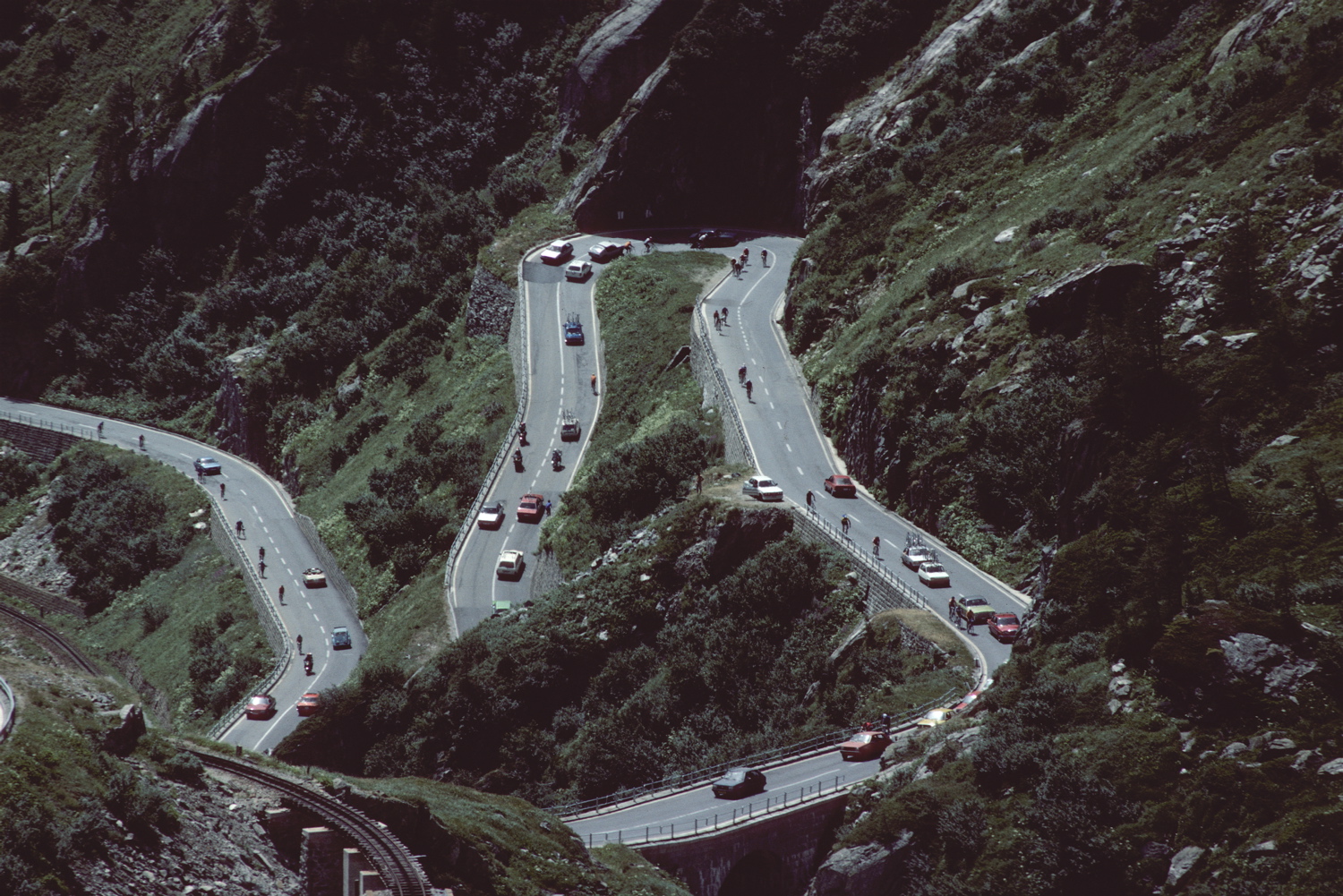Switzerland: 4 Passes, 106 Miles,
16,000 Vertical Feet
Good Samaritan, Grateful Rider
“With the blue Susten glacier vaulting to 12,000 feet across the narrow valley, I grind to a stop.”
“Even under ideal conditions,106 miles is a tough day. Given enough time, however, most serious cyclists can weather a century.”
Andrew Training For The Brevet
“The pass itself is organized chaos. Bicycle and cars squeeze into a single lane past the control table choking the cobblestone road.”
Susten Relief
“There I find high gear and spin the 12 miles down to Wassen”
Concrete As Weightless Art
I remember the exact moment when I shifted into my 42×28 stump puller. It was a mile after the road turned east at Innertkirchen, Switzerland and started the 18 mile, 5200 foot climb over the Susten Pass. For much of the day, low gear had served as insurance against grades that soared over 13%. Beyond the 42×28 there is only a hard tailwind, or a decreasing grade.
But I had overused low gear on the first three climbs and now, five miles short of the final summit, when I desperately need it, the air is stifling, and the only prayer I can summon speaks to the love of Jesus and not bigger lungs, or stronger thighs.
In this 90-degree heat, the will remains but the means have evaporated. My knees are screaming, my thighs, calves and back are numb and when I stand in the pedals and try to force the bicycle another dozen yards uphill, the road starts to swim and I weave dangerously close to a passing support car. With the blue Susten glacier vaulting to 12,000 feet across the narrow valley, I grind to a stop.
Grinding Toward The Susten Summit
It is 2:30 p.m. Eight and a half hours since 1,840 riders turned south from Andermatt, Switzerland toward the St. Gotthard Pass and the start of the Swiss Bicycle Association’s annual Alpen Brevet—the Alpine Award—a 106 mile, 16,000 vertical foot tour over four major Swiss passes.
Even under ideal conditions,106 miles is a tough day. Given enough time, however, most serious cyclists can weather a century. It’s the three miles of vertical—nearly half the height of Everest–that puts the steel in this ride and elevates it into the world’s toughest centuries.
Albert Hediger, creator of the Alpine Award and President of the Swiss Bicycle Association, insisted, “The Alpen Brevet is not a race. It is a major tour that attracts Europe’s best amateur cyclists. Fifty percent of the entries are over 40 years old—the oldest more than 70 the youngest is 16. Times are not kept. You will see, it is difficult enough just to finish. For that alone you must have trained 3,000 kilometers!”
Recalling three months of 200-400 mile weeks, I told him, “I’ve trained hard.”
“Yes, but kilometers on the flats are not enough,” he emphasized. “You must have trained in the mountains for strength as well as endurance. And if it is very hot, then well…”
The Brevet starts at 6:00 a.m. Even in August, the high mountain air contains a frosty edge and the first miles pass slowly. Until my legs warm, each down stroke is tight, labored. It is critical to stretch muscles– to start lubricants flowing through cold knees before the first climb. Ten miles into the ride, a colorful dragon winds around the Gotthard’s first switchback. Riders drop to their low gears and bend to the long grade that vaults to the still distant summit.
Cars,Riders, Passes Stamped, Gotthard Chaos
The pass itself is organized chaos. Bicycle and cars squeeze into a single lane past the control table choking the cobblestone road. My card is stamped and I rise through the gears as the descending grade falls through a series of ten percent straights and sharp hairpins. In seconds I am spun out in high gear on the ten mile downhill to the town of Airolo. Here the road turns west and climbs 4,400 feet in 14 miles across the Nufenen Pass. The resulting 6% average and 14% maximum grade exacts a toll. Conversations stop, water bottles are emptied and the pelaton starts to fracture. Support crews offer wet sponges and cold apples, but for some it is not enough. I see the first bike being loaded onto a car while a rider sits disconsolately along the road.
The SBA would like the Alpine Award to be viewed as a tough but pleasant tour through Switzerland’s most spectacular scenery. For the hundred riders who break off the front, it is a 106 mile time trial in which the scenery serves only as a distraction. Against the SBA’s gentlemen’s rules, the front pack is going for time. As I’m crossing the Nufenen I hear that the breakaway has cleared the Grimsel. If the report is true, I have last almost 90 minutes! It takes that long to descend the eight miles to Oberwald and then climb 2,600 feet (in 10 miles) to the pass. The heat is brutal on this sheer, rocky face and by the time I claim the summit, I am dehydrated and must stop.
On top of the Grimsel, the smell of liniment permeates the thin mountain air. Men work the white cream into their thighs, calves and knees. Few will admit it but they are finished. Knees have always been a cyclist’s nemesis, the weakest link in a dependable power train. Like a pitcher’s shoulder, or a runner’s hamstrings, when knees fail…game over.
My cyclometer touches 55 mph on the 16 mile downhill into Innertkirchen where the Alpen Brevet turns east toward the Susten Pass. The last and greatest vertical relief of the four passes, the Susten rises one mile in eighteen to a rocky glaciated summit. Winding through hardwood forests, the road passes old chalets, barns and small hotels, from which tourists shout encouragement and toast the riders with tall beers.
Three quarters of the way to the top, most riders are deep into their energy reserves. The pleasant comradery has been replaced by pain! A few riders cling to the door handles of their support vehicles. Others crowd roadside springs. No one smiles, or talks or looks up from the pavement. Faces portray a mix of exhaustion and determination.
Road From Wassen
I am five miles from the summit when my tank runs dry. I reef on the right peddle and my thigh only quivers in response. The bike stops. I sit on a stone wall and drink. Staring across the valley at the Stein and Trift glaciers, I know I cannot quit. I must finish. Fifteen minutes later I climb back in the pedals and push off.
I am mildly surprised when my first pedal stroke sends the bicycle creeping uphill. At a hundred yards I drink. At two hundred nearly stop. Yet, one down-stroke, a foot at a time, I eventually reach the summit. There I find high gear and spin the 12 miles down to Wassen where I turn south and struggle up the windy gorge, 1600 vertical feet to Andermatt.
If I had guessed the finish would be anticlimactic, I was right. There was no welcoming band, no cheering crowds or lovely frauleins to embrace the finishers. And yet, what I missed most, was an idea of where I placed. The first rider back, Gunther Haug of West Germany, smoked the circuit in 7 hours and fifteen minutes. That was three hours faster than me. No one bothered to record who was second, third or one thousand.
It took Peter Dent, an old friend from England who supported me without complaint during that long day to put it in perspective. “You’re looking at this Alpen Brevet ride all wrong!” he said at dinner that night. “No one times how long it takes to climb the Eiger’s North Wall. It’s enough simply to do it!



